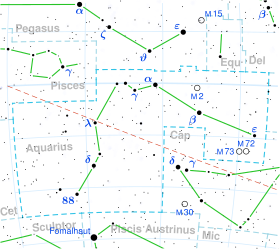3 Aquarii (abbreviated 3 Aqr) is a variable star in the equatorial constellation of Aquarius. 3 Aquarii is the Flamsteed designation; it also bears the Bayer designation k Aquarii and the variable star designation EN Aquarii. With a mean apparent visual magnitude of 4.429,[2] it is visible to the naked eye in dark skies. It has an annual parallax shift of 5.57 milliarcseconds with a 5% margin of error,[1] which translates to a physical distance of around 590 light-years (180 parsecs) from Earth.
| Observation data Epoch J2000 Equinox J2000 | |
|---|---|
| Constellation | Aquarius |
| Right ascension | 20h 47m 44.23898s[1] |
| Declination | –05° 01′ 39.7220″[1] |
| Apparent magnitude (V) | 4.429[2] |
| Characteristics | |
| Spectral type | M3 III[3] |
| U−B color index | +1.914[2] |
| B−V color index | +1.651[2] |
| Variable type | Lb[4] |
| Astrometry | |
| Radial velocity (Rv) | −22.0[5] km/s |
| Proper motion (μ) | RA: +1.68[1] mas/yr Dec.: −40.06[1] mas/yr |
| Parallax (π) | 5.57 ± 0.28 mas[1] |
| Distance | 590 ± 30 ly (180 ± 9 pc) |
| Absolute magnitude (MV) | −1.83[6] |
| Details | |
| Mass | 1.8[7] M☉ |
| Radius | 117.59+3.98 −4.21[8] R☉ |
| Luminosity | 1,771±128[8] L☉ |
| Surface gravity (log g) | 0.25[9] cgs |
| Temperature | 3,452±35[8] K |
| Other designations | |
| Database references | |
| SIMBAD | data |

With a stellar classification of M3 III,[3] this is a red giant star that has exhausted the hydrogen at its core and evolved away from the main sequence of stars like the Sun. The measured angular diameter of this star, after correction for limb darkening, is 5.60±0.70 mas.[13] At the estimated distance of 3 Aquarii,[1] this yields a physical size of about 108 times the radius of the Sun.[14] The effective temperature of the outer atmosphere is 3,450 K,[8] giving this star the cool, reddish hue of an M-type star.
The apparent magnitude of 3 Aquarii varies by up to 0.06 magnitudes, which was first noted in the 1960s.[15][16] It was formally listed as a variable star in 1973, and given the variable star designation EN Aquarii.[17] It is classified as an irregular variable,[4] although detailed analysis shows multiple possible periods.[18]
| Period (days) | 20.2 | 24.9 | 27.2 | 35.0 | 36.9 | 143.9 | 197.2 |
|---|---|---|---|---|---|---|---|
| Amplitude (magnitudes) | 0.020 | 0.038 | 0.027 | 0.021 | 0.024 | 0.022 | 0.027 |
References
edit- ^ a b c d e f g van Leeuwen, F. (November 2007), "Validation of the new Hipparcos reduction", Astronomy and Astrophysics, 474 (2): 653–664, arXiv:0708.1752, Bibcode:2007A&A...474..653V, doi:10.1051/0004-6361:20078357, S2CID 18759600.
- ^ a b c d Gutierrez-Moreno, Adelina; et al. (1966). "A System of photometric standards". Publ. Dept. Astron. Univ. Chile. 1. Publicaciones Universidad de Chile, Department de Astronomy: 1–17. Bibcode:1966PDAUC...1....1G.
- ^ a b Morgan, W. W.; et al. (1973). "Spectral Classification". Annual Review of Astronomy and Astrophysics. 11: 29. Bibcode:1973ARA&A..11...29M. doi:10.1146/annurev.aa.11.090173.000333.
- ^ a b Samus, N. N.; Durlevich, O. V.; et al. (2009). "VizieR Online Data Catalog: General Catalogue of Variable Stars (Samus+ 2007-2013)". VizieR On-line Data Catalog: B/GCVS. Originally Published in: 2009yCat....102025S. 1. Bibcode:2009yCat....102025S.
- ^ Wielen, R.; et al. (1999), "Sixth Catalogue of Fundamental Stars (FK6). Part I. Basic fundamental stars with direct solutions", Veröff. Astron. Rechen-Inst. Heidelb, 35 (35), Astronomisches Rechen-Institut Heidelberg: 1, Bibcode:1999VeARI..35....1W.
- ^ Anderson, E.; Francis, Ch. (2012). "XHIP: An extended hipparcos compilation". Astronomy Letters. 38 (5): 331. arXiv:1108.4971. Bibcode:2012AstL...38..331A. doi:10.1134/S1063773712050015. S2CID 119257644. Vizier catalog entry
- ^ Kervella, Pierre; Arenou, Frédéric; Thévenin, Frédéric (2022). "Stellar and substellar companions from Gaia EDR3. Proper-motion anomaly and resolved common proper-motion pairs". Astronomy and Astrophysics. 657: 657. arXiv:2109.10912. Bibcode:2022A&A...657A...7K. doi:10.1051/0004-6361/202142146. S2CID 237605138.
- ^ a b c d Baines, Ellyn K.; Thomas Armstrong, J.; Clark, James H.; Gorney, Jim; Hutter, Donald J.; Jorgensen, Anders M.; Kyte, Casey; Mozurkewich, David; Nisley, Ishara; Sanborn, Jason; Schmitt, Henrique R. (November 2021). "Angular Diameters and Fundamental Parameters of Forty-four Stars from the Navy Precision Optical Interferometer". The Astronomical Journal. 162 (5): 198. arXiv:2211.09030. Bibcode:2021AJ....162..198B. doi:10.3847/1538-3881/ac2431. ISSN 0004-6256. S2CID 238998021.
- ^ McDonald, I.; Zijlstra, A. A.; Watson, R. A. (15 June 2017). "Fundamental parameters and infrared excesses of Tycho–Gaia stars". Monthly Notices of the Royal Astronomical Society. 471 (1): 770–791. arXiv:1706.02208. Bibcode:2017MNRAS.471..770M. doi:10.1093/mnras/stx1433. eISSN 1365-2966. ISSN 0035-8711.
- ^ "* k Aqr". SIMBAD. Centre de données astronomiques de Strasbourg. Retrieved 2012-07-16.
- ^ "/ftp/cats/more/HIP/cdroms/cats". Centre de Données astronomiques de Strasbourg. Strasbourg astronomical Data Center. Retrieved 15 October 2022.
- ^ Koen, Chris; Eyer, Laurent (March 2002). "New periodic variables from the Hipparcos epoch photometry". Monthly Notices of the Royal Astronomical Society. 331 (1): 45–59. arXiv:astro-ph/0112194. Bibcode:2002MNRAS.331...45K. doi:10.1046/j.1365-8711.2002.05150.x. S2CID 10505995.
- ^ Richichi, A.; et al. (February 2005), "CHARM2: An updated Catalog of High Angular Resolution Measurements", Astronomy and Astrophysics, 431 (2): 773–777, Bibcode:2005A&A...431..773R, doi:10.1051/0004-6361:20042039.
- ^ Lang, Kenneth R. (2006), Astrophysical formulae, Astronomy and astrophysics library, vol. 1 (3rd ed.), Birkhäuser, ISBN 3-540-29692-1.. The radius (R*) is given by:
- ^ A. W. J. Cousins (1966). "Fabry photometry of bright southern stars". Royal Greenwich Observatory Bulletins. 122: 59. Bibcode:1966RGOB..122...59C.
- ^ Eggen, Olin J. (1969). "Narrow-and Broad-Band Photometry of Red Stars.IV. Population Separation in Giant Stars". The Astrophysical Journal. 158: 225. Bibcode:1969ApJ...158..225E. doi:10.1086/150186.
- ^ Kukarkin, B. V.; Kholopov, P. N.; Kukarkina, N. P.; Perova, N. B. (1973). "59th Name-List of Variable Stars". Information Bulletin on Variable Stars. 834: 1. Bibcode:1973IBVS..834....1K.
- ^ a b Tabur, V.; Bedding, T. R.; Kiss, L. L.; Moon, T. T.; Szeidl, B.; Kjeldsen, H. (December 2009). "Long-term photometry and periods for 261 nearby pulsating M giants". Monthly Notices of the Royal Astronomical Society. 400 (4): 1945–1961. arXiv:0908.3228. Bibcode:2009MNRAS.400.1945T. doi:10.1111/j.1365-2966.2009.15588.x.
